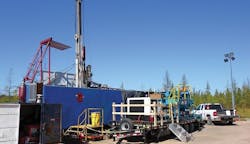Rio Tinto-led team exploring $6.2M Carbon Storage potential at Minnesota Metals Mine
A team led by mining giant Rio Tinto will explore the carbon storage potential at the Tamarack nickel-copper-cobalt project in central Minnesota.
The US Department of Energy is providing $2.2 million in funding through the ARPA-E Innovation Challenge and Rio Tinto will contribute an additional $4 million for the 3-year project. The Tamarack project is managed by Rio Tinto’s joint venture partner Talon Metals.
Rio Tinto’s technical experts will work with DOE’s Pacific Northwest National Laboratory (PNNL), Columbia University, Carbfix and Advantek Waste Management Services on the project and Talon Metals will provide ore body knowledge and land access for scientific field work.
More than One Way to Net Zero
See EnergyTech's full coverage of Carbon Storage in the C&I Sector
Subscribe to our free, tri-weekly Email Newsletter
Carbon mineralization is a process in which natural chemical reactions are used to convert captured CO2 into rock and stored underground. The technology has been used on a large scale by Carbfix in Iceland. It has the potential to contribute to meeting the global climate goals.
Rio Tinto Chief Scientist Dr Nigel Steward said, “Our aim is to deliver carbon storage solutions that can help to meet climate targets by reducing and offsetting emissions from our operations and in other industries, and to explore the emerging commercial opportunities carbon storage may offer at Rio Tinto sites around the world. We will be working with leading researchers and innovators to prove the carbon storage potential of the Tamarack site and develop mineralisation solutions that can be used not just here but at other similar locations.”
This Tamarack project will utilize knowledge gained from the Wallula Basalt Carbon Storage pilot underway in Washingon state. The federal researchers, PNNL and others are looking at flood basalt lava flows, which have flow tops that are porous, permeable, and have large potential capacity for storage of CO2
“We will be developing forward-looking carbon storage strategies with Rio Tinto and the broader team,” Todd Schaef, CO2 subsurface sequestration expert at PNNL, said in a statement. “PNNL stewards a suite of capabilities that allow us to look at real-time CO2 interactions with rocks under extreme conditions. We are proud to bring interdisciplinary expertise with computational scientists, geochemists, and engineers who have been researching the subsurface mineralisation of CO2 for decades.”
About the Author
EnergyTech Staff
Rod Walton is head of content for EnergyTech.com. He has spent 17 years covering the energy industry as a newspaper and trade journalist.
Walton formerly was energy writer and business editor at the Tulsa World. Later, he spent six years covering the electricity power sector for Pennwell and Clarion Events. He joined Endeavor and EnergyTech in November 2021.
He can be reached at [email protected].
EnergyTech is focused on the mission critical and large-scale energy users and their sustainability and resiliency goals. These include the commercial and industrial sectors, as well as the military, universities, data centers and microgrids.
Many large-scale energy users such as Fortune 500 companies, and mission-critical users such as military bases, universities, healthcare facilities, public safety and data centers, shifting their energy priorities to reach net-zero carbon goals within the coming decades. These include plans for renewable energy power purchase agreements, but also on-site resiliency projects such as microgrids, combined heat and power, rooftop solar, energy storage, digitalization and building efficiency upgrades.
